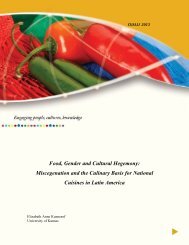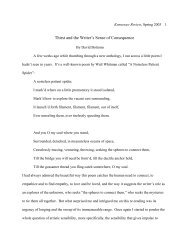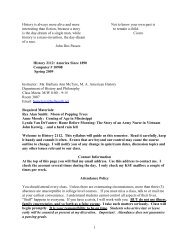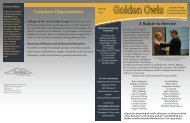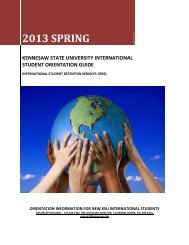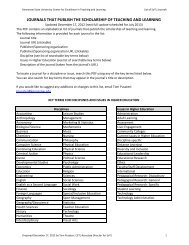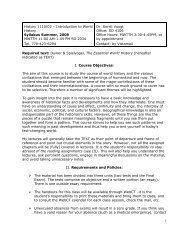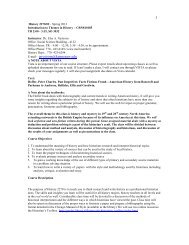Beyond Rosie: Women in World War II - Kennesaw State University
Beyond Rosie: Women in World War II - Kennesaw State University
Beyond Rosie: Women in World War II - Kennesaw State University
Create successful ePaper yourself
Turn your PDF publications into a flip-book with our unique Google optimized e-Paper software.
<strong>Beyond</strong> <strong>Rosie</strong>: <strong>Women</strong> <strong>in</strong> <strong>World</strong> <strong>War</strong> <strong>II</strong><br />
• How did work<strong>in</strong>g <strong>in</strong> the Savannah shipyards impact Tucker after the war?<br />
• How does Tucker describe male attitudes towards women <strong>in</strong> the workforce?<br />
3. Discuss the students answers to these questions as a class.<br />
Part 3: Oral History Analysis<br />
1. Distribute one of the five follow<strong>in</strong>g Oral History transcripts to each student:<br />
RUTH ASBELL IVEY http://www.kennesaw.edu/history/ivey.htm<br />
Oral history of the Bell Bomber Plant (Marietta, GA) secretary<br />
ERNESTINE J. SLADE http://www.kennesaw.edu/history/slade.htm<br />
African American Oral History of the Bell Bomber Plant (Marietta, GA). F<strong>in</strong>ish<strong>in</strong>g<br />
department employee.<br />
BETTY L. WILLIAMS http://www.kennesaw.edu/history/williams.htm<br />
Worked <strong>in</strong> the fuselage at the Bell Bomber Plant (Marietta, GA), sand<strong>in</strong>g, rivet<strong>in</strong>g, etc.<br />
KATHERINE O’GRADY “What did you do <strong>in</strong> the war, Grandma?”<br />
http://www.stg.brown.edu/projects/WW<strong>II</strong>_<strong>Women</strong>/Grandma.html<br />
Worked <strong>in</strong> a wool mill<br />
PAGE 24<br />
MILDRED CHATALIAN “An Adventure Despite Hard Times”<br />
http://www.stg.brown.edu/projects/WW<strong>II</strong>_<strong>Women</strong>/Adventure.html<br />
Worked <strong>in</strong> metal and wire factories<br />
2. Ask each student to answer the follow<strong>in</strong>g questions about their <strong>in</strong>dividual woman:<br />
• What is the name of the woman <strong>in</strong>terviewed?<br />
• What part of the United <strong>State</strong>s did she live and work dur<strong>in</strong>g WW<strong>II</strong>?<br />
• What was life like for the woman like before the war?<br />
• What type of job did the woman do <strong>in</strong> the factory?<br />
• Did they enjoy their work?<br />
• How did the work change how she viewed herself and how might others have viewed<br />
her?<br />
• How did this change <strong>in</strong> occupation/lifestyle affect her home life and change her life<br />
<strong>in</strong> general?<br />
• Did anyth<strong>in</strong>g change for the <strong>in</strong>terviewee after the war?<br />
• How did women go<strong>in</strong>g to work dur<strong>in</strong>g WW<strong>II</strong> change th<strong>in</strong>gs for women today?<br />
• What similarities and/or differences exist between this <strong>in</strong>dividual’s experience of<br />
work<strong>in</strong>g <strong>in</strong> <strong>World</strong> <strong>War</strong> <strong>II</strong> and Jane Tucker’s experience?<br />
3. Discuss the students’ answers as a class and ask the students that worked on the same<br />
<strong>in</strong>dividuals to present their <strong>in</strong>dividual’s story to the class as a team.



